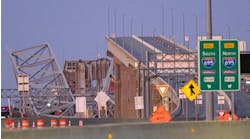By: Allen Zeyher, Managing Editor
Brooklyn Bridge, New York City
The Brooklyn Bridge could be called the toppest of the top-of-mind bridges.
Everybody knows it. It was a “signature” bridge before that awkward, inexplicable term started being applied to bridges by wily marketing types.
A bridge over the East River was talked about for many years as a way to move goods between Manhattan and Brooklyn. No one took action until 1855 when John Roebling, a famous bridge designer and owner of a wire-rope company, got frustrated with the ferry across the East River. He sketched out every detail of a suspension bridge that would clear the turbulence and heavy ship traffic of the East River. Roebling said his bridge was “to be ranked as a national monument . . . a great work of art.”
Roebling’s brilliant beginning on the road to constructing the Brooklyn Bridge came to a freak, uninspiring end in June 1869 when his foot was crushed on a pier by an incoming ferry. He later died of tetanus caused by his injury.
Roebling’s son Washington immediately took over as chief engineer. Ground was broken at the beginning of 1870. Work on the foundations has become famous (or infamous) for the strange, dangerous conditions inside the caissons used. The dim, flickering light and the noise of hammers, drills and other machinery made the conditions weird and dismal.
Then there was caisson disease. In the giant, airtight cylinders where the men worked below the riverbed to dig the space for the foundations, the air was compressed. When a worker returned to the surface of the earth, he suffered from “the bends,” nitrogen bubbles in the bloodstream, as if he had been deep-sea diving. Caisson disease killed 20 men and left Washington Roebling paralyzed.
Washington Roebling directed the rest of the construction of the Brooklyn Bridge from his Brooklyn home. His wife, Emily, made daily trips to the construction site and reported back to Washington on the progress. In fact, Emily studied bridge engineering and became an integral part of the team.
The two granite towers eventually rose to 276 ft. The four main cables, two outer and two inner, were as much as 15 in. in diameter. It was the first suspension bridge to use steel wire. The longest span of 1,595 ft was the longest for any suspension bridge in the world at the time, and the total length is 6,016 ft. The clearance below is 135 ft to accommodate sailing ships. The bridge opened on May 24, 1883, at a total cost of $15.1 million, twice the original estimate. The bridge now carries six lanes of traffic plus pedestrian walkways, and approximately 145,000 vehicles cross per day.
Many people over the years have waxed poetical about the Brooklyn Bridge. It certainly was a great engineering feat and a symbol of the greatness of New York and American technology.
Golden Gate Bridge, San Francisco
You, too, can have paint the same shade of orange vermilion that has become so familiar by its continuous use on the Golden Gate Bridge from a formula on the official Golden Gate Bridge website.
Construction began on Jan. 5, 1933. It was completed in April 1937 at a cost of $35 million. The center span of 4,200 ft was the longest suspension span in the world until the 1964 construction of the Verrazano-Narrows Bridge. It also had the world’s tallest suspension towers (500 ft above the roadway and 746 ft above the water) until 1957.
San Francisco-Oakland Bay Bridge, San Francisco to Oakland, Calif.
After deciding it was too expensive and cancelng it, California is back to the self-anchored suspension design that was originally proposed for the new $3.6 billion Bay Bridge.
The original Bay Bridge opened in 1936 as a double-deck structure. The west span was a pair of suspension spans. The east span was a combination of types. In the middle was the largest-diameter tunnel in the world through Yerba Buena Island.
Tacoma Narrows Bridge, Tacoma to Gig Harbor, Wash.
Mention the Tacoma Narrows Bridge and people immediately think of “Galloping Gertie,” maybe the most famous bridge failure in American history.
Local officials campaigned for decades for a bridge over the narrows. What they got was the third-largest suspension bridge in the world. It opened on July 1, 1940, and collapsed on Nov. 7, 1940.
Fewer people know that a second Tacoma Narrows Bridge was constructed and opened in 1950. The “Current Narrows Bridge,” as it is known, is also a suspension design, with a longest span of 2,800 ft and a total length of 5,979 ft. It was rebuilt using open components to allow wind to blow through and not exert so much force on the bridge.
Washington began construction in 2002 of another span across the Tacoma Narrows parallel to the Current Narrows Bridge. The new 5,400-ft-long, $615 million bridge is scheduled to be completed in 2007, hence it has been dubbed the “2007 Narrows Bridge.” It will be the longest suspension bridge built in the U.S. since 1964 and will add three lanes in each direction.
George Washington Bridge, New York to New Jersey
When the George Washington Bridge was opened in 1931 it was the longest suspension bridge in the world with a main span of 3,500 ft and a total length of 4,760 ft. In its original configuration, it held six lanes of traffic on what is now the upper level. Another two lanes were added in 1946. A second, lower level was constructed in 1962 with another six lanes of traffic. The GWB, as it is sometimes called, was the only suspension bridge in the world carrying 14 lanes. The bridge carried 108 million vehicles in 2004, according to Wikipedia.
The GWB connects New York with New Jersey over the Hudson River near the sites of Fort Washington, in New York, and Fort Lee, in New Jersey. The two forts were used by Gen. George Washington during the Revolutionary War in an unsuccessful attempt to prevent a British occupation of New York City in 1776.
Many different roadways from New York and New Jersey feed into the GWB, including one—U.S. 46 from New Jersey—that terminates at the state border in the middle of the bridge.
Carquinez Bridge, Vallejo to Crockett, Calif.
The first bridge across the Carquinez Strait linking Vallejo and Crockett, Calif., was built in 1927 and was the first major bridge in the San Francisco Bay area. To accommodate increasing traffic, a similar steel truss bridge was built in 1958. At that time, the 1927 bridge was dedicated to three lanes of westbound traffic, and the 1958 bridge had four lanes eastbound.
The Alfred Zampa Memorial Bridge was built alongside the 1958 bridge. The new suspension span replaces the 1927 bridge. It carries seven lanes of I-80 traffic, plus pedestrians and bicycles. Its total length is 3,465 ft and was opened in November 2003.
Cooper River Bridge, Charleston to Mount Pleasant, S.C.
The Cooper River Bridge, officially the Arthur Ravenel Bridge, named for a South Carolina state senator who helped secure the funding, is the longest cable-stayed span in North America, with an eight-lane main span of 1,546 ft. The $531 million design-build contract is the largest transportation infrastructure project completed by the South Carolina Department of Transportation.
It was dedicated and opened to traffic July 16, 2005.
The whole bridge structure including ramps is a total of 3.5 miles long.
Bob Graham Sunshine Skyway Bridge, Tampa, Florida
The Sunshine Skyway Bridge is the first U.S. cable-stayed bridge to have a single plane of stays. At 1,200 ft, its main span is the longest precast concrete segmental cable-stayed main span in the U.S.
Its aesthetics and engineering have won 17 design awards.
“Sunshine Skyway Bridge is a superb technical achievement and a work of art. The concrete bridge was constructed utilizing . . . precast segmental construction . . . resulting in a thin silhouette that seems to float in mid-air,” wrote the jury for the Presidential Medal through the National Endowment for the Arts.
The bridge was designed by Figg. The construction contractor was Paschen Contractors Inc. It was completed in 1987. In November 2005, the Florida State Legislature amended the bridge’s name to be the Bob Graham Sunshine Skyway Bridge in honor of the governor of Florida at the time the bridge was designed and constructed.
Leonard P. Zakim Bunker Hill Bridge, Boston
A very tight, urban location put constraints on the design for the bridge that would be part of Boston’s gigantic Central Artery/Tunnel project (aka the “Big Dig”). The design has been honored with 14 design awards.
The bridge is the widest cable-stayed bridge in the world at 183 ft, the first asymmetric cable-stayed bridge in the U.S. and the first cable-stayed bridge in the U.S. to use both steel and concrete in its frame. Another unusual feature is its two lanes of traffic cantilevered outside of the stay cables on the eastern side of the bridge. With the two cantilevered lanes, the bridge carries 10 lanes of traffic.
The $86.4 million bridge was conceived by Swiss bridge designer Christian Menn. The bridge has a 745-ft main span and an overall length of 1,457 ft.
New River Gorge Bridge, Fayetteville, W.Va.
The New River Gorge Bridge had a whole new claim to fame as of last year. The bridge’s image adorned West Virginia’s commemorative quarter. In fact, the bridge’s image was the only image on the tails side of West Virginia’s entry in the series of quarters minted by the U.S. to honor each state in the union.
The New River Gorge’s previous claims to fame were that at 876 ft above the New River it was the highest vehicular bridge in the Americas. Until the opening of the Millau Viaduct in France, it was the highest vehicular bridge in the world.
The bridge carries an average of 17,000 vehicles per day along U.S. Highway 19 near Fayetteville, W.Va. Residents of the area say the bridge’s opening in 1977 cut the time to cross the New River Gorge from 45 minutes to 45 seconds. Before its opening, travelers had to carefully follow winding mountain roads or take a 40-mile detour, according to PBS’s “Building Big” website.


